The Furniture: Brooklyn and Carol's Dramatically Different Department Stores
 Monday, March 21, 2016 at 10:20AM
Monday, March 21, 2016 at 10:20AM It's our new Production Design series, "The Furniture." Daniel Walber kicked things off last week with the bedroom in The Exorcist. Now a different era and public spaces - Editor
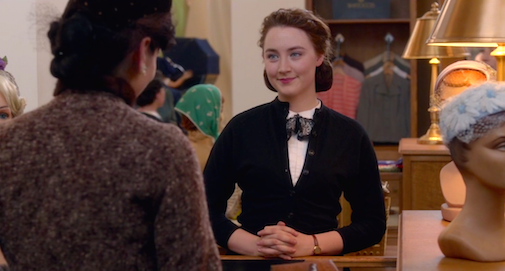
Thanks to Brooklyn and Carol, 2015 was a banner year for the 1950s department store. Both Eilis and Therese spend a fair amount of time as New York City shopgirls, selling to housewives and dealing with stern floor managers. Yet, despite the ostensibly common setting, Brooklyn's Bartocci's and Carol's Frankenberg's could not be more different.
The staff areas are a good place to start. Bartocci’s has a simple enough space for its employees, with open coat lockers to keep their belongings. It’s not beautiful, but the wood lends it a cozy quality. Production designer François Séguin (The Red Violin) and art directors Irene O’Brien (This Must Be the Place) and Robert Parle (Riddick) have a subtle, but assured touch. [More...]
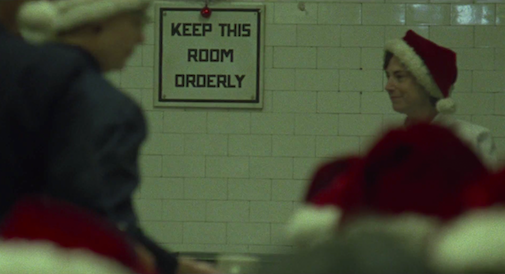
Frankenberg’s staff cafeteria, in comparison, feels subterranean. The walls are covered in the grim white tile of subway stations. A sign on the wall reads “KEEP THIS ROOM ORDERLY.”
But Therese seems not to notice, instead burying her nose in the store’s manual, another fine example of Frankenberg’s factory-esque ethos. This little book is a striking example of Carol’s detail, expertly arranged by production designer Judy Becker (interviewed) and art director Jesse Rosenthal, who previously worked together on Silver Linings Playbook and American Hustle.
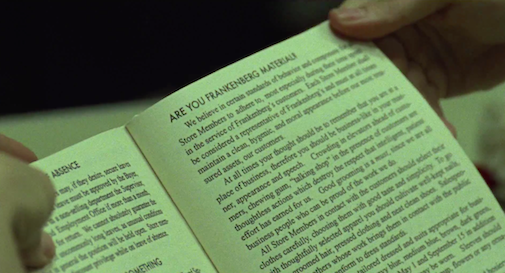
The difference in tone is even more obvious in the showrooms. Bartocci’s is bright, its display cases surrounded by warm woods and brass lamps. The occasional overhead shot of the space shows that it’s a very open space, bustling with women in bright colors and tasteful hats.
The ceiling is high and there's plenty of natural light, a fact made ever more clear by a shot of Eilis's supervisor watching her from above. The balcony, its bridal mannequins posing in front of stained glass, is about as lovely as a shopping center can get.
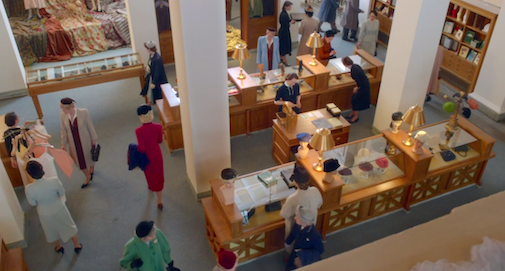
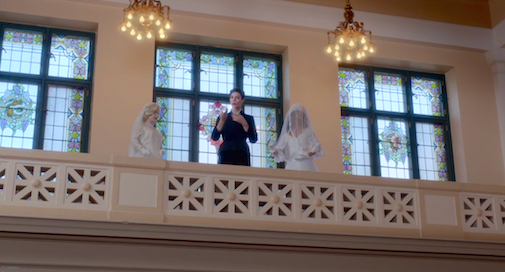
Frankenberg’s showroom, meanwhile, matches the staff room's underground vibe. The space is crammed with toys, all the way up to the evidently low ceilings. The walls are painted mint-green and accented peppermint wallpaper, as if the entire building has been remodeled to participate in this muffled display of Christmas cheer.
The doll cases in particular have an air of strained daintiness, much of which supplied by their own odd wallpaper.
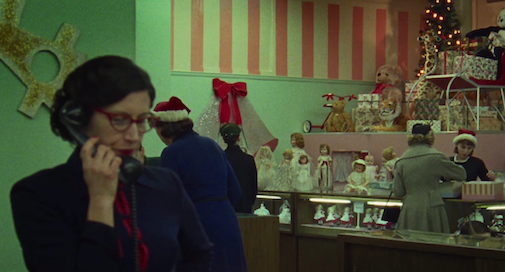
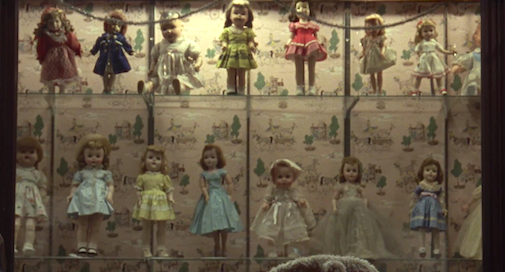
They're also thrown under the bus by Carol’s script, which distinguishes Therese as a girl who was more interested in train sets. The lifeless, occasionally creepy little model children are presented in opposition to the real people. Their miniature clothes, precious examples of stultifying 1950s femininity, have little in common with the costumes of Carol and Therese.
Brooklyn, meanwhile, has much less objectionable mannequins. Here, the production design and the costumes agree with one another. The disembodied head models wear hats that we might imagine Eilis wearing. She fits right into the store, and eventually does so quite happily.

Which, of course, all reinforces the dramatic role of Bartocci’s. The store is part of Eilis’s New York experience, a positive element in her growth toward self-fulfillment in America. Frankenberg’s, meanwhile, is the opposite. Therese grows out of it, just as she grows out of life with Richard. These settings are both entirely believable representatives of the department stores of the 1950s, but each is also imbued with dramatic meaning. And their production design is instrumental in communicating that to the audience.

more on Production Design | more Carol | more Brooklyn



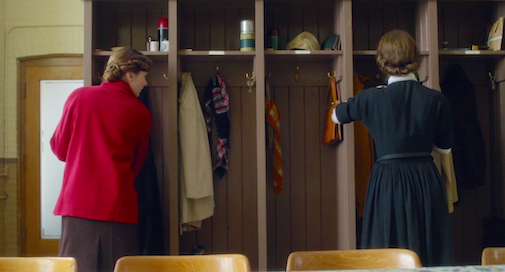
Reader Comments (17)
I read The Price of Salt before seeing the movie, and Therese's first chapter is amazingly whiny about how positively awful it is to work in a department store. Like, above Holden Caufield levels.
These spaces are so important for setting the moods of the movie. I love how the store in Brooklyn seems less imposing the more comfortable Eilis feels in it.
Meanwhile, the coldness of what should be a very friendly store in Carol (a toy store!) is just one of Carol's many perfect discords.
Love this article - these were indeed two of the most memorable movie locations in 2015, and they are both perfectly reflective of their film's respective moods and tones: Bartocci's is warm and bright, suited to Brooklyn's openness and love, while Frankenberg's is cold and cramped in comparison to the more open spaces of the Aird household and the open road, where Carol's lovers can be more themselves.
This is my new favorite series.
Well done! Marvellous article
Great piece. I just finished the novel Brooklyn and while Bartocci's isn't a terrible place to work by any means (for one thing, her boss, while stern, is fair & supportive), Eilis eventually finds the job boring and rather oppressive. The movie, which I loved, puts a somewhat rosier tint on everything.
For those of us who grew up in Montreal, Bertocci's had a familiar quality. That atmosphere of polished brass fixtures and walnut, with stained glass windows is none other than Birks jewelery, it's flagship store in downtown Montreal.
I grew up shopping with my mother in Montreal where a trip to Birks was always a bit like entering a friendly and very plush church. I loved that they used it's beautiful interiors for this film. So appropriate.
absolutely wonderful...thank you.
Thanks for the kind words, everyone!
Sean C. and Rob - I haven't read either book, but it's fascinating that Carol is more faithful on this point than Brooklyn. It's such a slight thing to change, but it ends up meaning so much.
LadyEdith - That's wonderful! Next time I'm in Montreal I'll have to stop by - I've never been, but I have spent a bunch of time in the Birks Building at McGill, which I guess was named after the founder of the jewelry company and is even more church-like!
I love that Therese was never a fan of dolls since dolls represent idealized versions of women that girls should aspire to be for the menfolk. Something Therese obviously doesn't identify with at all. That wallpaper in the doll cabinet, though! And the mint green! Yikes.
Great piece! The real question though: in which store would Freddie Quell be taking photographs?...neither space seems terribly inviting for a reckless WWII vet with bonding issues.
catbaskets -- love it. i think we'll have to put him in frankenberg's because it's already miserable. he'd get such a stinkeye from Therese's floor manager. (i love how much she clearly hates Therese in those scenes -- she's just fed up with her from the get go)
Amazing article, once again.
Fantastic new series, thank you! Just another reason to rewatch those films.
What a great idea for a series, and what a wonderful start!
I saw 3 movies with shop girls within one week: The Danish Girl, Brooklyn, Carol.
Redmayne was the best shop girl. Delighted by the female camaraderie, pleased to be out in the world, enthusiastic about his job, sweet with the customers.
Ronan was the next best. Courteous, hard working, conscientious, and trying to improve.
Mara was the worst. Lazy, grudging, snotty, and entitled. When her friend got her a job at the NY Times, for which she had no qualifications and experience, and her response was a vague annoyance that she had to put forth any effort at all, I just wanted to smack her.
What was the main character doing at the beauty counter when she would put
Some little tube things into a big brass thing? Was she sanitizing something?
The following website gives details of the location of the Bartocci's set - a former library in Montreal:
http://www.architecturaldigest.com/story/brooklyn-set-design